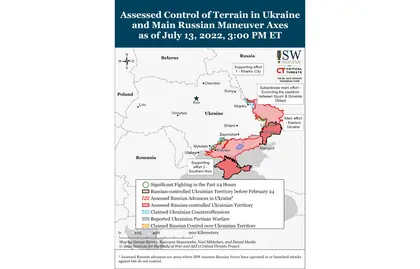Key Takeaways
- The Kremlin likely ordered Russian “federal subjects” (regions) to form volunteer battalions to deploy to Ukraine.
- Russian forces conducted failed ground assaults north of Slovyansk and around Bakhmut.
- Russian forces continued air and artillery strikes around Siversk and west of Donetsk City.
- Russian forces continued targeting Ukrainian rail lines on the Eastern Axis.
- Russian forces attempted limited and unsuccessful ground assaults north of Kharkiv City.
- Russian forces prioritized defensive operations on the Southern Axis as Ukrainian forces continued targeting ammunition depots.
- Russian occupation authorities are increasing financial incentives for civilians working in occupied Ukraine.
- Russian occupation authorities may be setting conditions to forcibly relocate Ukrainian children in occupied territories to Crimea.
The Kremlin likely ordered Russian “federal subjects” (regions) to form volunteer battalions to participate in the Russian invasion of Ukraine, instead of declaring partial or full mobilization in Russia.
JOIN US ON TELEGRAM
Follow our coverage of the war on the @Kyivpost_official.
Russian war correspondent and milblogger Maksim Fomin stated that Russia has begun a “volunteer mobilization,” where every region must generate at least one volunteer battalion. The term “volunteer mobilization” likely implies that the Kremlin ordered the 85 “federal subjects” (regions, including occupied Sevastopol and Crimea) to recruit and financially incentivize volunteers to form new battalions, rather than referring to literal mobilization relying on conscription or the compulsory activation of all reservists in Russia. Russian outlets reported that regional officials recruit men up to 50 years old (or 60 for separate military specialties) for six-month contracts and offer salaries averaging 220,000 to 350,000 rubles per month (approximately $3,750 to $6,000). Separate regions offer an immediate enlistment bonus that averages 200,000 rubles (approximately $3,400) issued from the region‘s budget and social benefits for the servicemen and their families.[3] Russian media has already confirmed the creation or deployment of volunteer battalions in Kursk, Primorskyi Krai, Republic of Bashkortostan, Chuvashia Republic, Chechnya, Republic of Tatarstan, Moscow City, Perm, Nizhny Novgorod, and Orenburg Oblasts in late June and early July. Tyumen Oblast officials announced the formation of volunteer units (not specifically a battalion) on July 7.

Kyiv Hit by Massive Drone Attack as Russian Strikes Target Multiple Ukrainian Cities
Volunteer battalions could generate around 34,000 new servicemen by the end of August if each federal subject produces at least one military unit of 400 men.
Some Russian reports and documentation suggest that the Kremlin seeks to recruit an estimated 400 soldiers per battalion, who will receive a month of training before deploying to Ukraine. The number of men may vary as some federal subjects such as Republic of Tatarstan and Chechnya are establishing two and four volunteer battalions, respectively. It is possible that some federal subjects may delay or not participate in the establishment of the battalions, with officials in Volgograd reportedly remaining silent on the formation of the new units. Newly formed battalions are currently departing to training grounds and will likely complete their month-long training by end of August but they will not be combat ready in such a short time period.
Russian milbloggers criticized the Russian military on July 12 for sourcing Iranian UAVs to improve artillery targeting in Ukraine while failing to address the command issues that more severely limit the effectiveness of Russian artillery.
Russian Telegram channel Rybar claimed on July 12 that Russian requests and approval for artillery fire pass through a convoluted chain of command, resulting in a delay of several hours to several days between Russian ground forces requesting artillery fire, Russian targeting, and conducting the actual strikes. Rybar claimed that Russian forces in Syria reduced the time between targeting and striking to under an hour. Rybar claimed that while the Russian need for more UAVs is clear and that Iranian UAVs helped achieve a target-to-fire time of 40 minutes in Syrian training grounds additional UAVs do not solve the problems of overcentralized Russian command and overreliance on artillery in Ukraine. Russian milblogger Voyennyi Osvedomitel’ claimed that Russian forces had faced the same overcentralized command during the First Chechen War, wherein the inability of Russian ground forces to request artillery support without going through a chain of command inhibited responses to enemy offensive actions. Milblogger Yuzhnyi Veter claimed that Ukrainian artillery forces’ target-to-response time is under 40 seconds.
Authors: Kateryna Stepanenko, Grace Mappes, George Barros, and Frederick W. Kagan.
Read the full report here.
You can also highlight the text and press Ctrl + Enter






